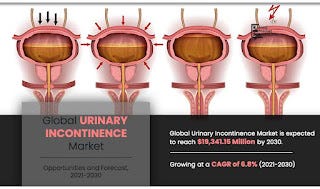Rise in incidence of urological disorders, in the last few years, has led to huge development of advanced urinary incontinence devices across the world. At the same time, increase in demand for minimally invasive surgeries and surge in aging population that is quite susceptible to urological issues have worked as the major factors boosting the growth of the urinary incontinence device market in several ways. Moreover, there’s also been a steep rise in the number of urinary incontinent patients swapping from conventional methods to highly advanced procedures. Moreover, growing healthcare outlays in the developing economies are expected to create a lot of opportunities for the frontrunners in the industry.
According to Allied Market Research, the global urinary incontinence device market is estimated to grow at a sizeable CAGR from 2021 to 2030. Complications like obesity, diabetes, certain neurological disorders, along with increase in the rate of ingesting foods such as carbonated, caffeine, and so on have augmented the risk of urinary incontinence in more than one way. Furthermore, there’s also been a steady incline in the number of people who drink and smoke excessively, which in turn has led to increasing cases of chronic diseases, thereby impacting the market positively . Also, growing geriatric population has been highly beneficial for the market growth.

Simultaneously, the ongoing trend of non-invasive treatment options has fueled the adoption of at-home expedients to deal with bowel incontinence. The prominent manufacturers are also offering pioneering products to magnify their product portfolio and achieve a competitive stance in the industry. As for example, the renowned sanitary products and medical & surgical devices manufacturing company in the United States, namely Kimberly-Clark Corporation came up with the Poise Active Collection of super-thin linings and wads for women. These permeable, ultra-thin pads happen to soak up the unwanted wetness and odor pretty instantly.
Advent of innovative urinary incontinence devices, surge in demand for minimally invasive procedures, shift from conventional solutions to novel urinary incontinent products, and efficiency in the prevention of hospital-acquired infections (HAIs) drive the growth of the global urinary incontinence market. However, lack of awareness regarding urinary incontinence devices, post-operative complications, and surge in concerns toward disposable products hinder the market growth. Rise in healthcare expenditures in the developing economies and increase in technology integration present new opportunities in the coming years.
Nevertheless, here, it’s worth mentioning that the outbreak of the pandemic resulted in a significant reduction in the number of outpatient tests and treatments, which had a negative impact on the global urinary incontinence devices market. Also, due to the pandemic, most of the leading players happened to come across a revenue drop in the urology sector. For example, in the fiscal year 2019–20, the interventional urology segment from Coloplast Corp confronted a negative growth of minus seven percent. However, the market is recovering on a gradual note and is projected get back on track soon.
Impact of COVID-19 Pandemic on the Urinary Incontinence Device Market:
COVID-19 is a large family of viruses that causes illness ranging from common cold to more severe respiratory diseases. The COVID-19 pandemic has limited the industry growth significantly, as the demand for urinary incontinence device decreased owing to decline in diagnostics and surgical procedures in the first half of 2020. According to the study published in the British Journal of Surgery, around 28.4 million elective procedures were cancelled or postponed in May 2020, based on a 12-week period of peak disruption to hospital services due to COVID-19. Thus, the outbreak of COVID-19 has negatively impacted the urinary incontinence device market.
- Outpatient clinics for urinary incontinence, benign prostatic hyperplasia, infertility, sexual medicine, benign scrotal conditions, renal stone, and bladder stone were mostly affected during the Covid-19 pandemic.
- Moreover, there was significant reduction in several types of non-urgent surgical treatments as healthcare staff has been shifted to take care of Covid-infected patients.
0 Comments